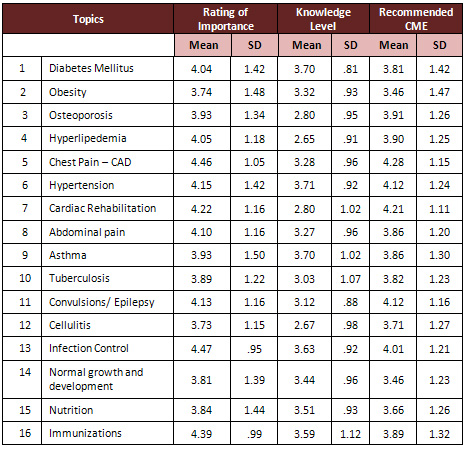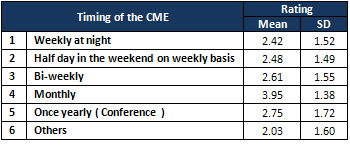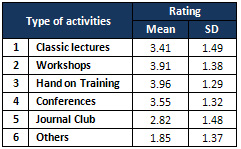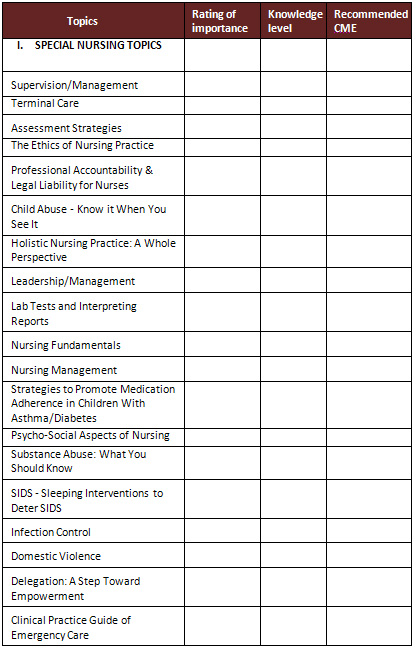| December
2016
- Volume 10, Issue 4
CME Needs Assessment: National Model - Nurses CME

|
 ( (
|
Ninette
Banday
Abdulrazak Abyad
Correspondence:
Dr Abdulrazak Abyad
Email: aabyad@cyberia.net.lb
|
|
Abstract
This CME Needs Assessment paper was written to provide
analysis on a particular regional country's <<the
country>> proposed CME in Nursing program and
can be used as a national model.
In this new millennium most
nations, both developed and developing are actively
reviewing national health policies and strategies as
well as health delivery systems. The over-riding imperative
in all cases is to deliver quality nursing care in a
cost efficient manner while addressing issues of access
and equity.
The provision of health services
in <<the country>> is divided into federal,
local and private sectors. The Health Authority, and
the local government agency is responsible for the provision
of integrated, comprehensive, and quality of health
services for its population.
|
Introduction
The vision of <<the country>> is "To
Provide World Class Healthcare." One of the first steps
to achieve this vision is to start comprehensive educational
programs to improve the skills of the primary health care
team as Primary Health Care is essentially the first level
of contact of the patient with the health care system. The
suggested programs include the following:
• Interdisciplinary Primary
Care Training Program. To assist medical centers in organizing
their delivery of care around the of primary care principals.
• Primary Care Physician Education Initiative (PCPEI).
The goals of the educational intervention are to better prepare
current physicians to deliver care under this new paradigm.
Need Assessment
Survey
In order to develop a comprehensive educational program for
the health care team there is a need to carry extensive need
assessment the first step in planning an educational activity.
In an attempt to assess the needs for professional development
of the medical, dental practitioners and nursing staff a survey
was conducted by means of a Questionnaire (APPENDIX 1) by<<the
country>>. The report takes into account a wide section
of the various medical, dental and nursing staff. The wide
range of topics that were covered in the survey is also well
elaborated in the report included the following
Results of Survey
Demographic Data
465 questionnaires were included in the study out of 600 hundreds
distributed. The exclusion criteria were that either the questionnaire
was not returned or was incomplete. The response rate was
77 percent.
CME Topics for Nurses
The results for the CME topics for the nurses are presented
in the Tables 30 and 31. Clinical
Practice Guide of Emergency Care, Professional Accountability
& Legal Liability for Nurses, Medication Adherence in
Children with Asthma/Diabetes, infection control and immunization
were some of the topics that received high ratings for the
need for CME activities.
Format of CME
The response rate for the monthly activity was the highest
with Hands - workshops.
Recommendations
It is clear that looking at tables in the report that the
respondents rated the importance of topics according to their
level of knowledge. It is an important concept that revealed
that the less knowledge they have about a topic was reflected
by less score on rate of importance. Therefore in planning
CME programs this should be taken into account.
Assessment Strategies
In the implementation of any CME activities assessment strategies
is critical to judge the success of such a program. For example
communication skills learning must be both formative and summative.
The knowledge, skills, and attitudes to be assessed must be
made explicit to both learners and teachers alike. Potential
evaluators include local experts, course faculty, simulated
and real patients, peers, and the learners themselves. Formative
assessment should occur throughout the communication skills
curriculum and is intended to shape and improve future behaviors.
Assessment of communication skills must include direct observation
of performance. Evaluation of setting a therapeutic environment,
gathering data and providing information and closure must
be included. Evaluation of advanced skills, including use
of interpreters, providing bad news and promoting behavior
change should be done as well. Criteria should match the novice
level of the end of second year student, who should be able
to identify the critical issues for effective communication
and perform the skills under straightforward circumstances.
It will be as well a good idea to
create a department of Family Medicine under the umbrella
of <<the country>> that help coordinate the implementation
of the different educational program, in addition to conducting
a number of ongoing research and academic activities.
Conclusions
Quality CME can enhance the knowledge base and practice skills
of the participating health care provider and is increasingly
used as part of the credentialing and reappointment process.
Continuing Medical Education is important not only as a requirement
for practice, but as means for the profession to achieve one
of its primary goals: QUALITY PATIENT CARE.
CME really is about changing behavior
through education-about doing something different, doing it
better." It is critical to look at CME and CPD in the
mentality of 21st century. We attempted to clearly present:
that the patient's concerns, values and outcomes must be the
center of care; that partnering with an activated patient
is essential; that self-awareness is essential in being an
effective physician; that improving the process of care and
health outcomes is the physician's responsibility and requires
a systems approach.
Quality CME can enhance the knowledge
base and practice skills of the participating health care
provider and is increasingly used as part of the credentialing
and reappointment process. Continuing Medical Education is
important not only as a requirement for practice, but as means
for the profession to achieve one of its primary goals: QUALITY
PATIENT CARE.
Introduction
to Project
In this new millennium most nations, both developed and developing
are actively reviewing national health policies and strategies
as well as health delivery systems. The over-riding imperative
in all cases is to deliver quality health care in a cost efficient
manner while addressing issues of access and equity.
By centering the focus of the program
on the patient, rather than who provides the functions and
services, we are best able to define our primary care program
as the provision of integrated, accessible, cost-effective
health care, wellness and preventative services through interdisciplinary
teams. These teams are accountable for addressing the healthcare
needs of their patients; developing a sustained partnership
with their patients and practicing in the larger context of
family and community.
Need Assessment
All health care disciplines share a common and primary commitment
to serving the patient and working toward the ideal of health
for all. While each discipline has its own focus, the scope
of health care mandates that health professionals work collaboratively
and with other related disciplines. Collaboration emanates
from an understanding and appreciation of the roles and contributions
that each discipline brings to the 'delivery of care experience'.
Such professional socialization and ability to work together
is the result of shared educational and practice experiences.
In order to develop a comprehensive
educational program for physicians, dentists, nurses and the
rest of the health care team there is a need to carry extensive
need assessment. Needs assessment is the first step in planning
an educational activity. Identification of needs provides
the basis for writing activity objectives. Many sources may
be used to establish needs. Physician needs may be determined
through prior activity evaluations and/or surveys of individual
needs. New advances in a clinical treatment may be identified
as an area in which further education is needed. Needs assessment
data may be drawn from surveys (on-site, email, Web site),
focus groups, expert consensus, faculty perception, formal
or informal requests from physicians, analyses of previous
evaluations, epidemiological data, environmental scans including
literature search/review, and quality assurance/improvement
data (e.g., gaps between practice guidelines and practice
performance, patient safety/institutional error data, and
information from external entities such as licensing boards
or certifying agencies, etc.).
It might seem self evident that the
need to learn should underpin any educational system. Indeed,
the literature suggests that, at least in relation to continuing
professional development, learning is more likely to lead
to change in practice when needs assessment has been conducted,
the education is linked to practice, personal incentive drives
the educational effort, and there is some reinforcement of
the learning. On the other hand, basing learning in a profession
entirely on the assessment of needs is a dangerous and limiting
tactic. So a balance must be struck.
The definition of Need
As in most areas of education, for many years there has been
intense debate about the definition, purpose, validity, and
methods of learning needs assessment. It might be to help
curriculum planning, diagnose individual problems, assess
student learning, demonstrate accountability, improve practice
and safety, or offer individual feedback and educational intervention.
Published classifications include felt needs (what people
say they need), expressed needs (expressed in action) normative
needs (defined by experts), and comparative needs (group comparison).
Other distinctions include individual versus organizational
or group needs, clinical versus administrative needs, and
subjective versus objectively measured needs. The defined
purpose of the needs assessment should determine the methods
used and the use made of the findings.
Exclusive reliance on formal needs assessment in educational
planning could render education an instrumental and narrow
process rather than a creative, professional one.
Methods of needs assessment
Although the literature generally reports only on the more
formal methods of needs assessment, doctors use a wide range
of informal ways of identifying learning needs as part of
their ordinary practice. These should not be undervalued simply
because they do not resemble research. Questionnaires and
structured interviews seem to be the most commonly reported
methods of needs assessment, but such methods are also used
for evaluation, assessment, management, education, and now
appraisal and revalidation.
Learning for needs
The main purpose of needs assessment must be to help educational
planning, but this must not lead to too narrow a vision of
learning. Learning in a profession is unlike any other kind
of learning.
Thus, educational planning on the
basis of identified needs faces real challenges in making
learning appropriate to and integrated with professional style
and practice. The first step is to recognize the need of learning
that are a part of daily professional life in medicine and
to formalize, highlight, and use these as the basis of future
recorded needs assessment and subsequent planning and action,
as well as integrating them with more formal methods of needs
assessment to form a routine part of training, learning, and
improving practice.
Methodology
Quality health care for patients is supported by maintenance
and enhancement of clinical, management and personal skills.
The knowledge and skills of practitioners require refreshment,
and good professional attitudes need to be fostered through
the process of continuing professional development. In an
attempt to assess the needs for professional development of
the medical, dental practitioners and nursing staff a survey
was conducted by means of a Questionnaire (APPENDIX 1) by<<the
country>>. This report takes into account a wide section
of the various medical, dental and nursing staff. The purposes
of the review, therefore were to:
•
Determine the area of professional development
• Help the primary
care physician, dentists, and nurses meet the challenge of
changes in the structure and delivery of patient care.
• Encourage more
reflection on practice & learning needs, including more
forward planning; and
• Make the educational
methods used in practice more effective
The topics that were covered in the
survey included the following
CME Topics for Nurses
• Special Nursing
Topics
• Medical Topics
Format of CME
Timing of the CME
Type of Activities
Self Study
Results
The results of the survey is presented in five parts, demographic
data, physicians, dental, nurses CME and preferences. Statistical
analysis was done using SPSS statistical package. The tables
below represent a summary of the data collected.
CME Topics for Nurses
Ratings for the CME topics for the nurses was also rated in
the same format as the physicians. The results are presented
in the Tables 30 and 31.
Click here for
Table 1: Special
Nursing Topics
Table 2: Medical Topics

It is clear from the above table that the level of knowledge
of the nursing staff in the medical topic is low which reflect
the lack of any CME program for the nursing staff.
In order to upgrade the skills of
nurses in primary health care there is a need to initiate
the Primary Care Nursing Education Initiative PCNEI. The goals
of the PCNEI are to :
• Provide Lifelong Learning
opportunities for professional nurses regarding the latest
developments, concepts, and research in advanced nursing practice
and the profession of nursing.
• Increase awareness in the nursing community of current
health care trends and practice issues.
• Collaborate with other health care professionals to
provide educational opportunities for nurses and other members
of the health care team.
It is important to show commitment
from the authority to professional development support for
nurses, for example:
• Professional continuing education
opportunities available and supported;
• Resource support for advanced education in nursing,
including RN-to-BSN completion programs and graduate degree
programs;
• Preceptorships, organized orientation programs, re-tooling
or refresher programs, residency programs, internships, or
other educational programs available and encouraged;
• Incentive programs for registered nursing education
for interested licensed practical nurses and non-nurse health
care personnel;
• Long-term career support program targeted to specific
populations of nurses, such as older individuals, home care
or operating room nurses, or nurses from diverse ethnic backgrounds;
• Specialty certification and advanced credentials are
encouraged, promoted, and recognized;
• APNs, nurse researchers, and nurse educators are employed
and utilized in leadership roles to support clinical nursing
practice; and
• Linkages are developed between health care institutions
and baccalaureate/graduate schools of nursing to provide support
for continuing education, collaborative research, and clinical
educational affiliations.
• What resources are committed to the ongoing professional
development of nurses, i.e. tuition, continuing education,
and certification?
• How much is budgeted annually per staff nurse for attendance
at professional development activities?
• Do you provide tuition reimbursement for nursing course
work completed towards obtaining the next higher degree?
In this era of increasing health
care workforce shortages, there is an ever expanding need
for high-quality professional nursing care due largely to
changes in the socio-demographics of the population and in
the health care system itself. There is a critical need for
PCNEI to fully utilize the knowledge and skills of professional
nurses and to ensure their continuous professional development,
and promote excellence in lifelong learning for all health
care providers. In today's challenging healthcare environment,
nurses committed to professional continuing education for
nurses help maintain the standards of nursing practice and
improve the health of the public.
Adult Learning Principles
In addition to being "champions," teachers
need to employ principles of adult learning in their approach
to teaching these topics. The knowledge base for any of these
topics is changing every day with the information and technology
explosion that has occurred in the last quarter-century. Genetics
is a perfect example of a topic subject to rapid, ongoing
revision based upon new research findings. Physicians must
learn how to identify their own learning needs and address
these needs effectively, in order to keep up with the ever-advancing
knowledge base in most of these topic areas.
Self-Awareness
In addition to fostering an enthusiastic approach to lifelong
learning, the instructional method must encourage physicians
to reflect upon their own lives in relationship to the topic.
The topic of geriatrics, for example, emphasizes many issues
that every student will face, through the aging of parents
and themselves. Substance abuse, end-of-life, and other topics
often elicit strong emotions within students, as physicians
remember past experiences or recognize ongoing struggles within
their own lives. Teachers must create environments that are
safe enough to foster trust and intimacy, and yet challenge
physicians to reflect upon their own experience of life, as
they develop a basic level of mastery in these special topic
areas
Format of
CME
Attempt was made to establish the most suitable timings
and frequency of the CME activities.
The ratings adopted were :
1 being least appropriate, 5 most
appropriate. The results are presented in the following tables
and the need for a monthly activity was rated highest 3.95
with Hands- on Training.
Table 3: Timing of CME

Table 4: Type of Activities

Table 5: Self Study Methods

Interactive formats are not inherently beneficial nor always
produce change. Some formats may be more conducive to specific
changes in behavior and some to support. Group dynamics, facilitation,
personal agendas, and internal and external influences contribute
to the complexity of the format. In general, the focus was
on choice of CME as opposed to other elements of the learning
cycle. This approach has been documented previously and reflects
the traditional approach to learning. It is well established
that CME should follow the principles of androgogy - adult,
self-directed learning. The term 'androgogy' has been coined
to describe the learning culture appropriate to adult education
. Whereas the term 'pedagogy' describes the teacher-centred
approach to the education of children, androgogy 'recognises
education to be a dynamic lifelong
process' that 'is learner-orientated'. This is grounded in
experiential learning - identifying and addressing needs and
applying learning with continuing reflection.
CME & CPD
for Nurses
The response of the nursing team to the survey was significant,
it reveals the high lack of CME activities for nurses at the
Emirate level. There is a great need to devise a comprehensive
CME program to improve the skills of the nursing team within
primary health care
Because the health care system is
evolving and changing rapidly, continuous efforts to survey
nurses and employers to identify content and skills needed
for educational programs in nursing are essential. In Nursing
learning is a life long process and continuing education is
an integral part of professional development. While graduate
and undergraduate education lead to formal academic degrees,
continuing professional education consists of those learning
activities intended to build upon the educational and experiential
basis of nurses.
Changes in the social, political,
economic and technological environments impact on the environment
for health and health care and on professional practice. These
changes provide challenges and opportunities for the nursing
profession to develop and support effective CME program. The
work environment for the practice of nursing has long been
cited as one of the most demanding across all types of work
settings. Nurses provide the vast majority of patient care
in hospitals, nursing homes, ambulatory care sites, and other
health care settings. The first objective of the professional
practice environment for nurses is to put the patient first.
Nurses and health care organizations must focus on patient
safety and care quality and always ask the question, "What
is best for our patients?"
In recent years a variety of factors
have converged to challenge the work environments of contemporary
nurses. Rapid advances in biomedical science, improved disease
prevention and management, integration of new clinical care
technologies, and shifts in care delivery to a broad array
of clinical sites have contributed to the rapidly increasing
need for well-educated, experienced nurses. Additionally,
population demographics are changing as the public ages in
growing numbers and becomes increasingly diverse in culture
and language. Exacerbating the challenges to the work environment
for nursing practice is the nationwide shortage of nurses
and other allied health professionals.
Conclusion
CME really is about changing behavior through education-about
doing something different, doing it better." The bottom
line of CME in the past has been the activities we produced-how
many, how much they cost, how many people came. In essence,
CME was more activity-oriented than learner-oriented. "Not
only do you have to focus on the learner," "you
have to focus on the learner in the context in which they
are learning, which is the healthcare environment where they
practice medicine." The aim of the proposal is to 'to
provide leadership in the delivery of high quality education,
for the primary care team, in the context of a caring and
vibrant academic environment'
It is critical to look at CME and
CPD in the mentality of 21st century. We attempted to clearly
present: that the patient's concerns, values and outcomes
must be the center of care; that partnering with an activated
patient is essential; that self-awareness is essential in
being an effective physician; that improving the process of
care and health outcomes is the physician's responsibility
and requires a systems approach.
Quality CME can enhance the knowledge
base and practice skills of the participating health care
provider and is increasingly used as part of the credentialing
and reappointment process. Continuing Medical Education is
important not only as a requirement for practice, but as means
for the profession to achieve one of its primary goals: QUALITY
PATIENT CARE. To our patients CME requirements are a commitment
made by the medical and dental practitioner to keep our knowledge
and skills current.
APPENDIX
SURVEY: CME TOPICS FOR NURSES
Please rate each of the topics below
(a) In order of importance for you
to have CME on the topic (1 = least important to 5 = most
important)
(b) By rating your own current level of knowledge of the topic.
(1 = basic to 5 = highly skilled)
(c) Recommend CME activity on level of priority. ( 1=least
to 5 = highest priority )


Any other skills or topic you feel are important for your
academic development:
Personal Information (optional)
Name ___________________________
Degree ___________________________
E-mail ___________________________
Work place _______________________
Are you willing to help in the teaching
process of the CME?
|




